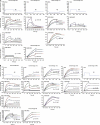Initial antibodies binding to HIV-1 gp41 in acutely infected subjects are polyreactive and highly mutated
- PMID: 21987658
- PMCID: PMC3201211
- DOI: 10.1084/jem.20110363
Initial antibodies binding to HIV-1 gp41 in acutely infected subjects are polyreactive and highly mutated
Abstract
The initial antibody response to HIV-1 is targeted to envelope (Env) gp41, and is nonneutralizing and ineffective in controlling viremia. To understand the origins and characteristics of gp41-binding antibodies produced shortly after HIV-1 transmission, we isolated and studied gp41-reactive plasma cells from subjects acutely infected with HIV-1. The frequencies of somatic mutations were relatively high in these gp41-reactive antibodies. Reverted unmutated ancestors of gp41-reactive antibodies derived from subjects acutely infected with HIV-1 frequently did not react with autologous HIV-1 Env; however, these antibodies were polyreactive and frequently bound to host or bacterial antigens. In one large clonal lineage of gp41-reactive antibodies, reactivity to HIV-1 Env was acquired only after somatic mutations. Polyreactive gp41-binding antibodies were also isolated from uninfected individuals. These data suggest that the majority of gp41-binding antibodies produced after acute HIV-1 infection are cross-reactive responses generated by stimulating memory B cells that have previously been activated by non-HIV-1 antigens.
Figures






References
-
- Alam S.M., Scearce R.M., Parks R.J., Plonk K., Plonk S.G., Sutherland L.L., Gorny M.K., Zolla-Pazner S., Vanleeuwen S., Moody M.A., et al. 2008. Human immunodeficiency virus type 1 gp41 antibodies that mask membrane proximal region epitopes: antibody binding kinetics, induction, and potential for regulation in acute infection. J. Virol. 82:115–125 10.1128/JVI.00927-07 - DOI - PMC - PubMed
-
- Alam S.M., Morelli M., Dennison S.M., Liao H.X., Zhang R., Xia S.M., Rits-Volloch S., Sun L., Harrison S.C., Haynes B.F., Chen B. 2009. Role of HIV membrane in neutralization by two broadly neutralizing antibodies. Proc. Natl. Acad. Sci. USA. 106:20234–20239 10.1073/pnas.0908713106 - DOI - PMC - PubMed
-
- Bar K.J., Keele B.F., Decker J., McLellan J., Salazar-Gonzales J., Salazar M., Li H., Wang S., Yang Y., Hahn B.H., Kwong P.D., Shaw G.M. 2009. P04-43. Neutralizing antibody responses against conformational envelope epitopes in early HIV-1 infection. Retrovirology. 6:P71

